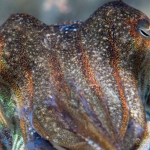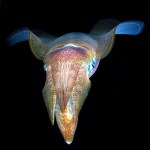squid
Last June (and May and July and part of August) we had a lot of precipitation in Minnesota. This caused lake levels to rise modestly. One lake, which is large enough to have meaningful waves, has older settlement along it so lots of cabins, boat houses, and such are right on the shoreline. With the lake level up, waves threatened the material possessions of rich white people, so naturally something had to be done. A No-Wake Rule was put into effect.
A No-Wake Rule means the oversized fishing boats and smallish cabin cruisers that normally ply this large exurban lake need to all go at 5 m…
Stunning footage of deep-sea squids from the Monterey Bay Aquarium Research Institute (MBARI), where researchers use remotely operated vehicles (ROVs) to observe and record deep-sea animal behaviors.
So a week back or so, a number of friends read an article about death by rectal eel and immediately thought of me. For those of you who missed the story, it went a little something like this:
* Chinese man gets drunk with friends and passes out
* Friends think it would be hilarious to insert a large living swamp eel into the man's butt while he is unconscious
* Hilarity does not ensue. In fact, the man dies. Chinese doctor says the eel "consumed the man's bowels"
The article was widely reported in major news outlets like CNN and the Times, but I am linking instead to the UK edition of…
A new study at the University of Wisconsin, Madison, has shed some light (oh... ZING!) on how squids may use another organ, along with their eyes, to see.
Some squids have a light organ on them which they use to camoflauge themselves from predators below them. The organ is filled with a luminous bateria that the squid can activate to light up. The idea is that the squids can illuminate their organs to match the light coming from the surface of the water, thus confusing a rising, hungry fish or giant crab monsters recently loose from attacking deep sea oil drilling stations.
By studying the…
In the darkness of the deep ocean, some animals create their own light. Among these is the Hawaiian bobtail squid Euprymna scolopes, which forms a partnership with the luminous bacterium Vibrio fischeri. The squid houses colonies of these bacteria in special light organs, and it can control the brightness and direction of their illuminations. But these organs do much more than produce light - they detect it too.
Deyan Tong from the University of Wisconsin has discovered that the organs generate nervous signals when they sense light and they're loaded with proteins responsible for detecting…
The giant cephalopods (squids and octopuses) of the deep sea have captured the imagination for centuries. But despite our fascination with these creatures, they are still enigmas, their behaviour illuminated only by the occasional lucky video or the presence of scars on animals they fight with. For many species, including the famous giant squid, we still know relatively little about what they eat and what position they occupy in their ecosystems.
Yves Cherel from the Centre d'Etudes Biologiques de Chize has some new answers about the behaviour of deep-sea cephalopods and they came from a…
The Japanese pinecone fish searches for food with living headlights. This ÂÂhand-sized fish harbours colonies of light-producing bacteria in two organs on its lower jaw. The beams from these organs shine forward, and when night falls and the fish goes searching for food, its jaw-lamps light the way.
Elsewhere in the Pacific Ocean, the Hawaiian bobtail squid also uses luminous bacteria, but theirs act as a cloaking device. They produce a dim glow that matches the strength of moonlight from above, hiding the squid's silhouette from hungry fish below. It's a mutual relationship; the squid gets…
Very cool video of a bizarre squid from the genus Magnapinna. Also known as bigfin squid, few specimens have ever been observed and only a handful ever captured. The squid in this footage has tentacles 20 feet long.
This footage was filmed in the Gulf of Mexico off the coast of Houston, Texas by cameras attached to deep sea oil rig.
Some times I find myself in random corners of the Interweb, pleasantly lost, and then I come face to face with the piglet squid!
Unaccustomed to Earth's atmosphere, the visitor quickly perished.
The following info is from a short press release provided by the Cabrillo Marine Aquarium when they found this little tyke.
Piglet Squid, Helicocranchia pfefferi
This funny looking squid is about the size of a small avocado and can be found most commonly in the deepwater (greater than 100 m or 320 ft) of virtually all oceans. Its habit of filling up with water and the funny location of its siphone…
Rumor has it that New Zealand's colossal squid is a refined killing machine, hunting down prey at lightening speed deep in the murky Antarctic depths. Turns out rumor may be wrong. Scientists working on the largest ever whole specimen of colossal squid have made some curious discoveries. Far from being a fearsome deep sea warrior, this specimen appears to be an overweight blob suited only for floating slowly and pumping out eggs.
The 1000+ pound squid was hauled in accidentally by a fishing boat last winter. Click here to see our coverage when the story initially aired. These findings…
tags: Underwater Astonishments, marine biology, evolution, streaming video
David Gallo shows jaw-dropping footage of amazing sea creatures, including a shape-shifting cuttlefish, a pair of fighting squid, and a mesmerizing gallery of bioluminescent fish that light up the blackest depths of the ocean. He focuses on the work of two scientists: Edith Widder at the Ocean Research & Conservation Association, and Roger Hanlon at the Marine Biological Lab. [6:01]
Back in March of 2007, we brought you the story of an enormous (colossal really) squid, captured by New Zealandish fishermen and brought back for examination at the University of New Zealand. The frozen squid posed challenges for the researchers who realized that it would take so long to thaw that the outer parts would be rotting before the core had even melted (also an appropriate description of my brother Benny's heart).
Well the marine biologists made their move today, thawing out the colossal squid in a bath of cool water. Had the water been too hot, they were worried it might crack the…
Thanks to two readers, the infamous Mike Witherspoon and the illustrious Tanya Poon, we have been alerted to two mega-sweet articles in the New York Times.
The first from the Science Times yesterday tells the story of Cape Coral, Florida, a coastal town that was alarmed by a strange noise coming from the ocean which "reverberat[ed] through their homes." The townsfolk- mostly retirees -almost got their government to dish out $47,000 to an engineering company to fix the municipal utility system that they blamed for the racket. Turns out it was the powerful mating calls of a fish called the…
Imagine that you hand is made of jelly and you have to carve a roast using a knife that has no handle. The bare metal blade would rip through your hypothetical hand as easily as it would through the meat. It's clearly no easy task and yet, squid have to cope with a very similar challenge every time they eat a meal.
The bodies of squid, like those of their relatives the cuttlefish and octopus, are mainly soft and pliant, with one major exception. In the centre of their web of tentacles lies a hard, sharp and murderous beak that resembles that of a parrot. The beak is a tool for killing…
France's National Museum of Natural History displayed its prize centerpiece today for an exhibit on biodiversity, a plastinated, 21+ foot-long, giant squid named Wheke. The squid was hauled in by a fisherman in New Zealand in 2001 and was plastinated in Italy by a company called VisDocta Research. The process, in which all of the squid's water, fat and other liquids are replaced with a hardening plastic filling, took two and a half years and cost approximately $100,000.
I am looking forward to plastinating Andrew's dog, Izzy, some day. Maybe for an anniversary gift?
Wheke would be so happy…
Normally, I keep my blog away from Squid and other cephalopods because I know that if PZ myers feels threatened, he may charge, and the squiggly molluscs are his bailiwick.
But, this evening at the Laden household analog of the dinner table, the question came up: "How many species of cephalopods are there, anyway? Huh?"
So I went on line to look, and before I got anywhere near the answer to this interesting question, I came across the Vampire Squid, Vampyroteuthis infernalis. This turns out to be an animal of great extremes....http://animaldiversity.ummz.umich.edu/site/accounts/…
tags: mollusc, photography, subway art, art, Boston, Logan Airport
The photographer writes: I love the pictures you have posted of the subway mosaics. Thought you might be interested to know that other forms of transportation (Boston's Logan Airport) have attempted their own such art. Well, not really -- these are not elaborate terrazzos, but simply floor tile designs -- but they are still fun. There are sea stars, eels, angler fish, whales, seahorses, and of course octopuses, squid, and cuttlefish.
Image: Digital Cuttlefish [wallpaper size].
Your pictures I truly adore
So, for your…
According to the Tree of Life project, Promachoteuthis sulcus is known from a single, small (25 mm ML, sex unknown) but distinctive individual from great depths in the south Atlantic Ocean. Now Benny and I are no cephalopodologists, but those chompers look a little different from the typical squid beak which we have come to know and fear.
Those of you looking to find or avoid the aforementioned denture squid should steer clear of here: 36°49'S, 12°17'W off Tristan Da Cunha, south Atlantic Ocean. Captured from WALTHER HERWIG at 1750-2000 m depth (open net).
Kevin Z? PZ? Other…
The AP just reported that project leader Dr. Larry Madin of the Woods Hole Oceanographic Institution and Phillipine scientists returned from two weeks in the Celebes Sea, located off the Phillippines southernmost archipelago, this Tuesday with some potential new deep sea discoveries. Among the more interesting finds were a strange black jellyfish, a transparent sea cucumber and a spiny orange worm that had 10 squid-like tentacles. "I'll have to try a bite of each one with Old Bay before we determine whether they are truly new species or not" Dr. Madin joked. Adding, "you think I'm kidding,…

